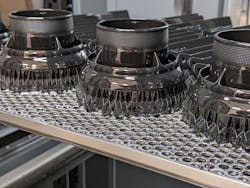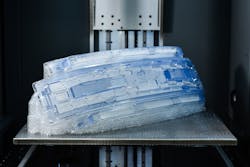Additive manufacturing giant Stratasys is in the middle of a consolidation bidding war, with competitors 3D Systems and Nano Dimension Ltd. trying to buy the Israeli/American company while it has launched its own bid to merge with rival Desktop Metal.
Typically, during such boardroom battles, top executives stay silent and let their lawyers do all of the talking. Yet Stratasys CEO Yoav Zeif recently spent more than an hour talking to IndustryWeek editors about why the 3D-printing world is in the midst of such a feeding frenzy, what needs to happen to get additive techniques up to mass-production scale and where the technology should be going in the next few years. (Update: Stratasys Again Rejects 3D Systems)
We’ll break down those topics in this three-part series. Part 1, why now? Why are investors and rivals acting now to consolidate an additive manufacturing industry that still struggles to generate profits? Expect parts 2 and 3, covering scaling 3D printing technologies and what the future holds for additive in the coming weeks. (Part 2: How Additive Can Scale)
IndustryWeek: What is going on in the 3D space right now that’s leading to all this financial maneuvering? Why now?
It’s all about the cost per part. Because if I cannot meet the cost, then what am I doing here?... And when I’m saying cost per part, it’s the total cost of ownership. It’s the inventory, the logistics, the design, the assembly, everything. It’s not just comparing how much it costs to print versus injection molding.
[Then] it’s the part properties, what this part needs to deliver in terms of strength, in terms of temperature and any other metric that you can think about.
And then, last but not least, I need the workflow. [When] I was managing a plant, if someone came to me with a solution, let’s say a compounder or an extruder that I could not connect to my MES and ERP, it had no value to me. We need to be there as a 3D printing industry.
IW: Why is the inflection point now? Why not five years ago, 10 years ago?
YZ: It’s a combination of getting to this critical moment where the technology is starting to be good enough, we have enough materials....
It’s a push and a pull.
The push is that the industry is becoming more mature. We have the right materials, because many years ago, a few years ago even, there were not enough materials to address the needs [of customers]…. The technology like the hardware, it’s more reliable. We start putting everything into a workflow under the cover of a full digital thread.
But no less important, is the pull.
How many challenges does a manufacturer have? Many. And those challenges were really emphasized during the COVID epidemic—the whole issue of supply chain and the fact that you need protection or some type of insurance to make sure that you get, in time, the inputs that you need and the parts that you need in order to produce.
Then you have global trends of personalization and customization. You have global trends of new technological solutions that require new geometries and lighter parts, which is exactly what we can deliver. Like the electric vehicles trend. Like aerospace. You need lighter parts, you need new geometries that no one thought about and you need them now.
Additive Gets More Mature
YZ: You need to meet manufacturing standards, and we were not there. Gradually, we are getting there, and this is a great success story that we have.
And on the pull side, we are solving the problems. We are solving the short batches, the supply chain issues, the sustainability [challenges].
When the Ukraine war started, suddenly we had more demand in some of the European countries. [Our sales partners] told me those are [manufacturers] that are using CNC machines and they need parts, but the energy cost jumped six times. Six times. And they made the calculation that they can do the same part with additive manufacturing and the energy will be much lower than with a CNC machine.
IW: Many additive companies are losing money. Are finances playing a role in this merger craze?
YZ: For sure.
The fact is that the only public company, I want to say the only company, but I don't have all the data on private companies in additive manufacturing, so I’ll say the public companies, but out of the entire space, the only public company out of all the additive manufacturing players in the world that is profitable for eight quarters in a row is Stratasys.
[Editor’s note: Stratasys has reported positive adjusted earnings, but on a generally accepted accounting principles (GAAP) measure, the company lost $60.4 million in the first half of 2023, $29 million in 2022 and $62 million in 2021.]
As a leader, I believe that you need to create value, and the ability to be profitable is a demonstration of value creation. Because otherwise you are doing things, but how do you know that those things are really creating value?
Having said that, it’s also clear that when you go to manufacturing, now you’re not just putting a machine in front of your customer, or a printer, but you come with a full package that solves his or her problem. Then you need to invest much more, because now we are not investing only in a printer. We are investing in a printer, in a software platform, in a material platform, in service and also in post processing.
We put everything under one digital thread. It costs a lot to develop this. And, if it costs a lot, you need in order to really be successful and solve the problems of your customer and add value to your customers, you need to make sure that you have enough scale to invest.
Zeif, “Scale is not only the revenue numbers.“
You don’t have one silver bullet for each application. It means that we are a very segregated … kind of industry.
This is the beauty of our merger with Desktop Metal [Editor’s note: Stratasys shareholders are scheduled to vote on the proposed Desktop Metal merger on Sept. 28.] Desktop Metal is focusing on binder jetting…. So, you have two companies, and we have DLP and they have DLP, but you have two companies where at the end you have two, not more than two, maybe three core technologies, across different technologies, and then you create scale.
If you have five or six or seven technologies, and each one of the technologies is completely different, you cannot use the same software or you cannot use the same material or you cannot use the same print heads.
My vision is to lead across different technologies, but to lead with platforms. You will have one print head… you have embedded software, and you have hardware and you have electronics around it…. That’s the essence of scale. That’s what leads this industry to consolidation.
IndustryWeek Senior Editor-at-Large Geert De Lombaerde contributed to this article.






